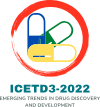Speaker
Description
Osteoarthritis (OA) is a non-communicable disorder of multiple etiologies/origins, estimated to affect more than 500 million people worldwide which is 7% of the world population. while there are no pharmacological interventions other than pain management, understanding the mechanism and intertwined pathways is essential for developing a formulation addressing this multifactorial disorder. We employed a combination of software and database explorations to determine the antioxidant and anti-inflammatory properties of curcumin and green tea in this study. For data mining and network construction, PubChem, Binding database Disgenet, and Cytoscape v3.8.0 were used. Furthermore, the data was enriched using String v11.5, KEGG, and Gene Ontology (GO) to comprehend OA cellular processes and phytoconstituent’s drug potential. The possible targets associated with bioactive components of curcumin and green tea were segregated and corresponding genes associated with humans were analyzed. The protein-protein interaction (PPI) associated with genes were analyzed and possible connections of OA-associated genes with critical signaling pathways, like the Hypoxia inducible factor-1 (HIF-1) signaling pathway, Apelin signaling pathway, arginine proline metabolism, and arachidonic pathway were discovered through network pharmacological studies. The network pharmacological study found the curcumin and green tea bioactive components such as Demethoxycurcumin and Epigallocatechin gallate targets the HIF-1 signaling pathway, Apelin signaling pathway, arginine proline pathway simultaneously. Imbalance in the HIF-1 Signaling pathway leads to OA development via destabilizing the balance of Reactive Oxygen Species (ROS) in Synoviocytes. Similarly, the arachidonic pathway is associated with nitric oxide formation and oxidative stress. Curcumin and Green tea have synergistic potential action when used towards OA. In addition, the bioactive components of these molecules will be tested as potential treatments for OA and related illnesses.
Bibliography:
-
Scanzello CR, Goldring SR (2012) The role of synovitis in osteoarthritis pathogenesis. Bone 51: 249–257. DOI: https://doi.org/10.1016/j.bone.2012.02.012.
-
Hunter DJ, March L, Chew M. (2020) Osteoarthritis in 2020 and beyond: a Lancet Commission. Lancet 396: 1711–1712. DOI: https://doi.org/10.1016/S0140-6736(20)32230-3.
-
Chenevier-Gobeaux C, Simonneau C, Lemarechal H, Bonnefont-Rousselot D, Poiraudeau S, Rannou F, Ekindjian OG, Anract P, Borderie D. (2013) Effect of hypoxia/reoxygenation on the cytokine-induced production of nitric oxide and superoxide anion in cultured osteoarthritic synoviocytes. Osteoarthr Cartil 21(6): 874-881. DOI: https://doi.org/10.1016/j.joca.2013.03.010.
-
Eom DW, Lee JH, Kim YJ, Hwang GS, Kim SN, Kwak JH, Cheon GJ, Kim KH, Jang HJ, Ham J, Kang KS. (2015) Synergistic effect of curcumin on epigallocatechin gallate-induced anticancer action in PC3 prostate cancer cells. BMB Rep 48: 461–466. DOI: https://doi.org/0.5483/BMBRep.2015.48.8.216
